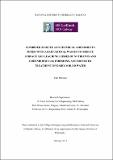| dc.description.abstract | Agricultural activity is a major source of nutrient emissions to surface and ground waters and a significant contributor to greenhouse gas emissions. Despite legislation to improve terrestrial water quality, prescribed targets are not being met. This is against a background of more intensive farming practices such as concentrated animal feeding operations, which have led to large volumes of manures being generated in relatively small areas and spread at rates that exceed plant nutrient demand. The competing demands of providing more food from the same land area, while simultaneously reducing environmental impacts, is a major challenge. While many mitigation measures to reduce nutrient losses, such as crop and land management, have been put forward, these alone will not achieve the necessary improvements in water and air quality. The main nutrients of concern are phosphorus (P), which mainly contributes to coastal and freshwater eutrophication, and nitrogen (N), which has adverse impacts on human and livestock health through leaching to groundwater. Increased losses of carbon (C) also adversely impact the atmosphere through greenhouse gas emissions. New techniques which are sustainable, economical, and which do not negatively impact the atmosphere, aquatic ecosystems or human and animal health, are therefore required to reduce this form of non-point agricultural pollution. Similarly, a greater understanding of the removal mechanisms and factors affecting the performance of existing treatment technologies, such as aerobically operated farm filters, is needed.
This laboratory-based study examined the effectiveness of applying combined zeolite and either polyaluminum chloride (PAC) or alum amendments to reduce losses of N, P, C and suspended solids (SS) from surface applied dairy and pig slurries, and dairy soiled water (DSW), when subjected to varying interval rainfall events. Traditionally, such studies aimed to reduce only P in the surface runoff; however, this study aimed to identify an optimal amendment to the slurries and DSW to simultaneously reduce N, P, C and SS. Once an optimal rate of amendment was determined, their impact – if any – on leaching losses of N, P and C, and on emissions of carbon dioxide (CO2) and methane (CH4), were quantified. Separately, a passive filter study using woodchip and sand media to investigate the impacts of media depth, organic loading rates (OLRs), and media type to treat DSW, was also undertaken.
The study concluded that combined use of zeolite and chemical amendments when mixed with dairy and pig slurries and DSW, reduced losses of N, P and SS in surface runoff to a much greater extent than those from unamended slurries. The combined amendments were most effective when mixed with dairy slurry, followed by pig slurry, and were least effective when used with DSW. The impact of the amendments was correlated with the dry matter (DM) content of the slurries and the relative effectiveness of the amendments to flocculate P, N and SS-enriched slurry particles. Although the amendments were also effective in reducing C losses, their use may not be economically viable, given the relatively low amounts of C measured in runoff from unamended slurries compared with the amounts applied. Use of the combined amendments did not reduce leaching losses of N, P and C, or gaseous emissions of CO2 and CH4 from pig slurries and DSW, when compared to unamended slurries. While they reduced leaching losses of C from dairy slurries, they also increased CO2 emissions. The greatest short term threat of nutrient leaching and gaseous emissions of CO2 and CH4 was posed by pig slurry, in both amended and unamended forms.
Intermittently loaded woodchip filters were assessed to be more economically and environmentally effective in treating DSW than sand filters; however, their removal mechanism for all contaminants was physical as opposed to biological. While the sand filters nitrified DSW effluent [43±18 mg nitrate-N (NO3-N) L-1] for the first 85 days of operation, concentrations reduced thereafter to 7.2±1.6 mg NO3-N L-1. The woodchip filters did not nitrify the effluent, even at relatively low loadings of 35 g chemical oxygen demand (COD) m-2 d-1. The final filtered effluent from both sand and woodchip filters, however, was above the concentrations at which it may be legally discharged to receiving waters. Options for its reuse may be to use the treated effluent in irrigation and, in time, to incorporate the spent timber residue into the soil.
The potential of mixing zeolite and chemical amendments with agricultural slurries to mitigate environmental impacts must be considered in the context of traditional conservation and nutrient management practices, which would appear to be the most cost effective strategies over the long term. The N, P, and C mitigation measures described in this study may provide more immediate water quality benefits, at overloaded ‘legacy’ sites or ‘critical source areas’, where manure additions are already restricted to crop removal rates. Prior to use of the new techniques described in this study, a cost-benefit analysis of applying amendments to organic wastes, and to on-farm filter treatment of DSW will be essential in the context of whole-farm and watershed-scale nutrient management. Such an analysis should only be carried out after long term field-scale studies, and should also address management and legislative issues related to discharge consents for on-farm treated agricultural wastes and to selected use of manure amendments. | en_IE |


